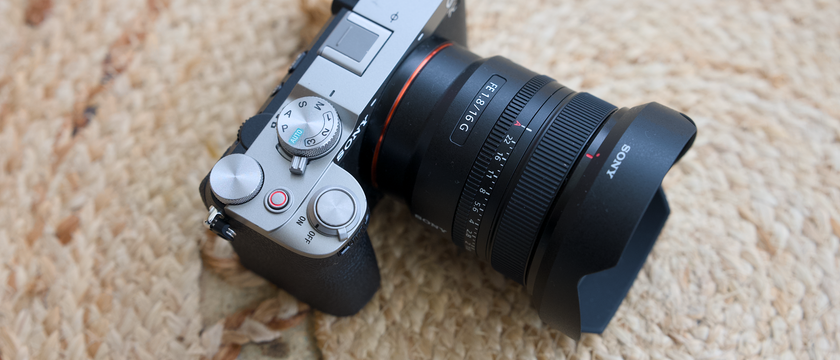TechRadar Verdict
This camera delivers high quality, correctly exposed images with plenty of detail, good colour and well-controlled noise. The featureset is also impressive the touchscreen well-implemented.
Pros
- +
Small camera body
- +
Plenty of direct controls
- +
Excellent EVF
- +
High quality images
- +
Weather sealed
Cons
- -
LCD not variangle
- -
Some features hard to find
- -
High price
Why you can trust TechRadar
• Updated: Firmware 2.0 page added
The Olympus E-M1 is the latest addition to the Olympus compact system camera (CSC) line-up and it's aimed at professional and enthusiast photographers. It doesn't replace the Olympus OM-D E-M5, but sits above it. Until now the OM-D E-M5 has been largely referred to as the Olympus OM-D, but it seems we will have to get used to calling it the Olympus E-M5.
We've already covered these models in the Techradar camera reviews section. We gave the Olympus OM-D E-M5 4 stars and the more recent OM-D E-M10 5 stars.
Olympus hopes that the new OM-D E-M1 will address the needs of Four Thirds users as well as enthusiast Micro Four Thirds users, because it has a dual autofocus system that is designed to work well with both types of lens.
Although Olympus's earlier Micro Four Thirds cameras are compatible with Four Thirds lenses, the contrast detection autofocus system is very slow with the older design of lens.
The E-M1 has Olympus's new Dual Fast AF system which combines contrast and phase detection systems. While we have seen this type of thing elsewhere, Olympus claims to use a different design from other manufacturers.
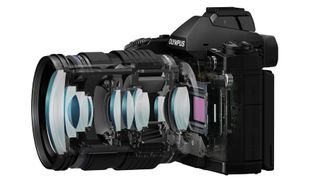
Some of the pixels on the E-M1's 16MP sensor are actually half-photosites (pixels) with no colour filter. One row has left-half sites while another has right-half receptors. These two halves match up to create a phase detection focusing system which is used when Four Thirds lenses are mounted on the camera.
Olympus uses this approach because the photosites (strictly speaking pixels don't exist on a sensor, just in an image) used for focusing don't gather any image data. This means the information needs to be interpolated - just as it would with a dead pixel on the sensor.
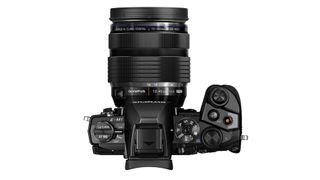
In addition, like other compact system cameras, the E-M1 has a contrast detection AF system that also uses information from the imaging sensor. This is used to drive the focus of Micro Four Thirds lenses on the E-M1. The camera automatically detects what type of lens is mounted and uses the appropriate AF system automatically.
When Micro Four Thirds lenses are used in continuous autofocus mode, both focusing methods are used as it increases the focusing speed.
The camera uses contrast detection in movie mode whether the lens is a Four Thirds or Micro Four Thirds optic.
Features
In a first for Olympus, the 16MP Live MOS sensor in the OM-D E-M1 has no low-pass filter over it. This should enable it to record more detail than the original Olympus OM-D, the OM-D E-M5.
In addition, we are told that new TruPic VII image processor has been calibrated to put the emphasis on detail visibility at the expense of a little noise.

Thanks to the new processing engine, lateral chromatic aberrations are corrected and sharpness optimisation according to the lens mounted and aperture selected (for Olympus lenses). This should enable users to get the best from their camera and lens combination.
Olympus claims that the E-M1 produces the best image quality from any Olympus digital camera, with less colour saturation loss at high sensitivities. We look forward to testing this claim in the near future.
As it's a compact system camera, the Olympus E-M1 doesn't have an optical viewfinder, but there's an electronic one with 2,360,000 dots and 1.48x magnification. This magnification and dot-count should make it easier to see details than usual. Uniquely, in HDR preview mode this viewfinder is capable of showing the effect (there are two HDR modes, Natural and Artistic) as well as the image building up in Live Bulb mode.

This EVF can also use adaptive brightness technology to adjust it to the brightness of the environment and take the size of the photographer's pupil into account. In bright light the EVF is brighter, while in dark conditions it's darker. This is a default setting, but it can be switched off if users prefer.
A new feature called Colour Creator allows hue and saturation to be adjusted using a colour wheel that's visible on screen and in the viewfinder. The effect is also previewed in the EVF and on the screen. Saturation can be increased by up to three steps and decreased by up to four steps, which makes in the image monochrome. There are 30 points around the wheel to tone the image.
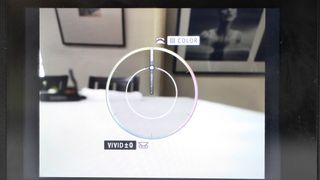
This can be combined with the Highlight and Shadow control to tailor images to users preferences or to create a particular style. These can be saved as part of the My Mode settings for future use.
Although the E-M1 uses the same five-axis all mechanical Image Stabilisation (IS) system as the E-P5, it makes a small improvement in performance. However, new changes to the CIPA standard mean that this is now billed as a four-stop correction rather than five. Consequently, the camera can be handheld at shutter speeds up to four stops slower than without IS. That's the equivalent of dropping from 1/125sec to 1/8sec.
Those more interested in freezing movement will appreciate the E-M1's top shutter speed of 1/8000sec, just like the E-P5.
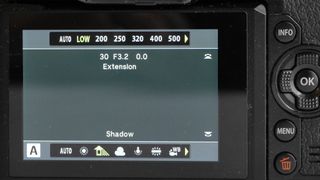
It's also possible to shoot continuously with continuous AF at 6.5fps for 50 raw files, or at 10fps with single-AF mode selected for 41 raw files. We are told that the better housing around the shutter mechanism means that the E-M1 is quieter than the E-P5 in action.
Olympus has had a lot of success with its Art Modes and the E-M1 introduces a new mode, Diorama II, which as well as allowing you to have the sharp area around the focus point, can be used with vertical format images.

It would strange for a new camera not to have Wi-Fi connectivity built-in now and the E-M1 doesn't disappoint as it has the same system as is in the E-P5. However, in a slight upgrade, this enables remote shooting via Olympus's (upgraded) smartphone app in all exposure modes with control over exposure and white balance.
In addition, the image can be seen forming on the screen of the smartphone during long exposures captured using Live Bulb and Live Time mode.



















